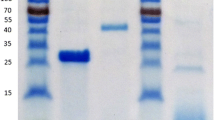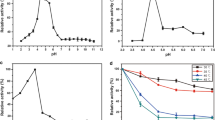Abstract
An arabinoxylan arabinofuranohydrolase (AXS5) was purified from the culture filtrate of Penicillium chrysogenum 31B. A cDNA encoding AXS5 (axs5) was isolated by in vitro cloning using the N-terminal amino acid sequence of the native enzyme as a starting point. The deduced amino acid sequence of the axs5 gene has high similarities with those of arabinoxylan arabinofuranohydrolases of Aspergillus niger, Aspergillus tubingensis, and Aspergillus sojae. Module sequence analysis revealed that a “Glyco_hydro_62” was present at position 28–299 of AXS5. This is a family of α-l-arabinofuranosidases which are all members of glycoside hydrolase family 62. Recombinant AXS5 (rAXS5) expressed in Escherichia coli was highly active on arabinoxylan but not on branched sugar beet arabinan. 1H-NMR analysis revealed that the rAXS5 cleaved arabinosyl side-chains linked to C-2 and C-3 of single-substituted xylose residues in arabinoxylan. Semi-quantitative RT-PCR analysis indicated that expression of the axs5 gene in P. chrysogenum 31B was strongly induced by adding d-xylose and arabinoxylan to the culture medium. Moreover, two binding sites of XlnR, a transcriptional activator that regulates the expression of the genes encoding xylanolytic enzymes, are present in the upstream region of the axs5 gene. These results suggest that AXS5 is involved in xylan degradation.




Similar content being viewed by others
References
Beldman G, Schols HA, Pitson SM, Searle-van Leeuwen MJF, Voragen AGJ (1997) Arabinans and arabinan degrading enzymes. Adv Macromol Carbohydr Res 1:1–64
Bourgois TM, Van Craeyveld V, Van Campenhout S, Courtin CM, Delcour JA, Robben J, Volckaert G (2007) Recombinant expression and characterization of XynD from Bacillus subtilis subsp. subtilis ATCC 6051: a GH 43 arabinoxylan arabinofuranohydrolase. Appl Microbiol Biotechnol 75:1309–1317
Chávez R, Bull P, Eyzaguirre J (2006) The xylanolytic enzyme system from the genus Penicillium. J Biotechnol 123:413–433
Ferré H, Broberg A, Duus JØ, Thomsen KK (2000) A novel type of arabinoxylan arabinofuranohydrolase isolated from germinated barley—analysis of substrate preference and specificity by nano-probe NMR. Eur J Biochem 267:6633–6641
Gielkens MMC, Visser J, De Graaff LH (1997) Arabinoxylan degradation by fungi: characterization of the arabinoxylan-arabinofuranohydrolase encoding genes from Aspergillus niger and Aspergillus tubingensis. Curr Genet 31:22–29
Kaji A, Tagawa K (1970) Purification, crystalization and amino acid composition of α-l-arabinofuranosidase from Aspergillus niger. Biochim Biophys Acta 207:456–464
Kimura I, Yoshioka N, Kimura Y, Tajima S (2000) Cloning, sequencing and expression of an α-l-arabinofuranosidase from Aspergillus sojae. J Biosci Bioeng 89:262–266
Komae K, Kaji A, Sato M (1982) An α-l-arabinofuranosidase from Streptomyces purpurascens IFO 3389. Agric Biol Chem 46:1899–1905
Kormelink FJM, Searle-Van Leeuwen MJF, Wood TM, Voragen AGJ (1991a) (1, 4)-β-d-Arabinoxylan arabinofuranohydrolase: a novel enzyme in the bioconversion of arabinoxylan. Appl Microbiol Biotechnol 35:231–232
Kormelink FJM, Searle-Van Leeuwen MJF, Wood TM, Voragen AGJ (1991b) Purification and characterization of an (1, 4)-β-d-arabinoxylan arabinofuranohydrolase from Aspergillus awamori. Appl Microbiol Biotechnol 35:753–758
Kormelink FJM, Gruppen H, Voragen AGJ (1993) Mode of action of (1–4)-β-d-arabinoxylan arabinofuranohydrolase (AXH) and α-l-arabinofuranosidases on alkali-extractable wheat-flour arabinoxylan. Carbohydr Res 249:345–353
Laemmli UK (1970) Cleavage of structural proteins during the assembly of the head of bacteriophage T4. Nature 227:680–685
Lowry OH, Rosebrough NJ, Farr AL, Randall RJ (1951) Protein measurement with the Folin phenol reagent. J Biol Chem 193:265–275
Matsushika A, Inoue H, Kodaki T, Sawayama S (2009) Ethanol production from xylose in engineered Saccharomyces cerevisiae strains: current state and perspectives. Appl Microbiol Biotechnol 84:37–53
Numan MT, Bhosle NB (2006) α-l-Arabinofuranosidases: the potential applications in biotechnology. J Ind Microbiol Biotechnol 33:247–260
Rahman AKMS, Kato K, Kawai S, Takamizawa K (2003) Substrate specificity of the α-l-arabinofuranosidase from Rhizomucor pusillus HHT-1. Carbohydr Res 338:1469–1476
Rombouts FM, Voragen AGJ, Searle-van Leeuwen MF, Geraerds CCJM, Schols HA, Pilnik W (1988) The arabinanases of Aspergillus niger-purification and characterisation of two α-l-arabinofuranosidases and an endo-1, 5-α-l-arabinanase. Carbohydr Polym 9:25–47
Saha BC (2000) α-l-Arabinofuranosidases: biochemistry, molecular biology and application in biotechnology. Biotechnol Adv 18:403–423
Sakamoto T, Kawasaki H (2003) Purification and properties of two type-B α-l-arabinofuranosidases produced by Penicillium chrysogenum. Biochim Biophys Acta (General subjects) 1621:204–210
Sakamoto T, Thibault JF (2001) An exo-arabinanase of Penicillium chrysogenum able to release arabinobiose from α-1, 5-l-arabinan. Appl Environ Microbiol 67:3319–3321
Sakamoto T, Yamada M, Kawasaki H, Sakai T (1997) Molecular cloning and nucleotide sequence of an endo-1, 5-α-l-arabinase gene from Bacillus subtilis. Eur J Biochem 245:708–714
Sakamoto T, Ihara H, Kozaki S, Kawasaki H (2003) A cold-adapted endo-arabinanase from Penicillium chrysogenum. Biochim Biophys Acta (General subjects) 1624:70–75
Sambrook J, Fritsch EF, Maniatis T (1989) Molecular cloning: a laboratory manual, 2nd edn. Cold Spring Harbor Laboratory, Cold Spring Harbor
Sanger F, Nicklen S, Coulson AR (1977) DNA sequencing with chain-terminating inhibitors. Proc Natl Acad Sci USA 74:5463–5467
Somogyi M (1952) Notes on sugar determination. J Biol Chem 195:19–23
Sørensen HR, Jørgensen CT, Hansen CH, Jørgensen CI, Pedersen S, Meyer AS (2006) A novel GH43 α-l-arabinofuranosidase from Humicola insolens: mode of action and synergy with GH51 α-l-arabinofuranosidases on wheat arabinoxylan. Appl Microbiol Biotechnol 73:850–861
Van den Berg MA, Albang R, Albermann K, Badger JH, Daran JM, Driessen AJ, Garcia-Estrada C, Fedorova ND, Harris DM, Heijne WH, Joardar V, Kiel JA, Kovalchuk A, Martín JF, Nierman WC, Nijland JG, Pronk JT, Roubos JA, van der Klei IJ, van Peij NN, Veenhuis M, von Döhren H, Wagner C, Wortman J, Bovenberg RA (2008) Genome sequencing and analysis of the filamentous fungus Penicillium chrysogenum. Nat Biotechnol 26:1161–1168
van den Broek LAM, Lloyd RM, Beldman G, Verdoes JC, McCleary BV, Voragen AGJ (2005) Cloning and characterization of arabinoxylan arabinofuranohydrolase-D3 (AXHd3) from Bifidobacterium adolescentis DSM20083. Appl Microbiol Biotechnol 67:641–647
Van Laere KMJ, Beldman G, Voragen AGJ (1997) A new arabinofuranohydrolase from Bifidobacterium adolescentis able to remove arabinosyl residues from double-substituted xylose units in arabinoxylan. Appl Microbiol Biotechnol 47:231–235
Van Laere KMJ, Voragen CHL, Kroef T, Van den Broek LAM, Beldman G, Voragen AGJ (1999) Purification and mode of action of two different arabinoxylan arabinofuranohydrolases from Bifidobacterium adolescentis DSM 20083. Appl Microbiol Biotechnol 51:606–613
van Maris AJA, Abbott DA, Bellissimi E, van den Brink J, Kuyper M, Luttik MAH, Wisselink HW, Scheffers WA, van Dijken JP, Pronk JT (2006) Alcoholic fermentation of carbon sources in biomass hydrolysates by Saccharomyces cerevisiae: current status. Antonie Van Leeuwenhoek 90:391–418
van Peij NNME, Visser J, de Graaff LH (1998a) Isolation and analysis of xlnR, encoding a transcriptional activator co-ordinating xylanolytic expression in Aspergillus niger. Mol Microbiol 27:131–142
van Peij NNME, Gielkens MMC, de Vries RP, Visser J, de Graaff LH (1998b) The transcriptional activator XlnR regulates both xylanolytic and endoglucanase gene expression in Aspergillus niger. Appl Environ Microbiol 64:3615–3619
Weinstein L, Albersheim P (1979) Structure of plant cell walls. IX. Purification and partial characterization of a wall-degrading endo-arabanase and an arabinosidase from Bacillus subtilis. Plant Physiol 63:425–432
Acknowledgment
This research was financially supported in part by grants-in-aid for scientific research (22580091) from the Japan Society for the Promotion of Science.
Author information
Authors and Affiliations
Corresponding author
Rights and permissions
About this article
Cite this article
Sakamoto, T., Ogura, A., Inui, M. et al. Identification of a GH62 α-l-arabinofuranosidase specific for arabinoxylan produced by Penicillium chrysogenum . Appl Microbiol Biotechnol 90, 137–146 (2011). https://doi.org/10.1007/s00253-010-2988-2
Received:
Revised:
Accepted:
Published:
Issue Date:
DOI: https://doi.org/10.1007/s00253-010-2988-2




